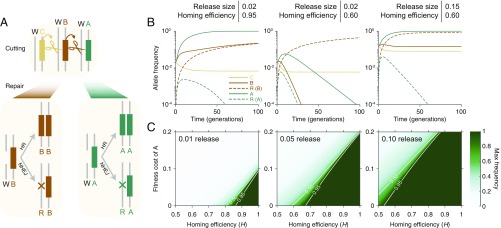Fig. 2.
Dynamics of CBA daisy-chain gene-drive systems. (A) After being cut by an upstream daisy allele, a wild-type allele is repaired either by homologous recombination (HR), creating a second copy of the other allele at the locus, or by nonhomologous repair (e.g., NHEJ), leading to generation of a resistant allele. This process occurs in the germline and is independent at each locus. We assume that resistance at the cargo locus, A, is dominant lethal if inherited. (B) A highly efficient daisy drive ( homing efficiency) with an fitness cost for the cargo element seeded at spreads the cargo nearly to fixation (Left). (B, Center) A low-efficiency drive () with the same initial release size no longer allows drive spread. (B, Right) Increasing the release size of the inefficient drive to again allows cargo spread to near fixation. (C) The maximum (Max) frequency achieved by cargo alleles as a function of the homing efficiency and the cargo fitness cost, for release sizes of (Left), (Center), and (Right). Throughout, we assume a fitness cost for C and B elements and neutral resistant alleles at the C and B loci.

